
The Orgies Mysteries Theatre of Hermann Nitsch
A conversation with Hermann Nitsch
In cooperation with the VV Foundation and the Nitsch Foundation, Hermann Nitsch’s solo exhibition Orģiju un mistēriju teātris will open at Latvia’s Museum of Decorative Arts and Design (Skārņu iela 10, Riga) in March 2021. In the 1960s, Hermann Nitsch – together with Günter Brus, Otto Muehl, and Rudolf Schwarzkogler – formed one of the most radical art movements of the 20th century – Viennese Actionism. Nitsch acknowledges that the Orgies Mysteries Theatre (Das Orgien-Mysterien-Theater), which he created in the late 1950s and describes as an intense artistic experience that combines painting, theatre, music and poetry with liturgical and religious elements, is his life work. At the core of the Orgies Mysteries Theatre is the idea of creating something more than a theatrical production, which Nitsch believes is possible only when both spectator and actor are equally involved. In a sense, it is a form of art therapy that the Viennese Actionists arrived at by gradually studying the works of Sigmund Freud and Wilhelm Reich. When it comes to the Orgies Mysteries Theatre, one cannot just passively observe and remain neutral; as Otto Muehl said: ‘Our activity was not only a form of art but, above all, an existential attitude’.
Ritual is one of the most important components of Nitsch’s art. As early as the 1960s, his Actions were described as an ‘aesthetic form of prayer’ depicting both Dionysian and Christian rituals. In general, Nitsch’s entire body of work can be seen as a ritualised activity in which the same Actions/performances, comprised of similar elements, are conceived and performed again and again, as visually similar large-format abstract compositions containing the shirts of performance participants are painted in a performative way.

The exhibition at the Museum of Decorative Arts and Design will feature the most significant art rituals of Hermann Nitsch: documentary videos showing the Actions of the Orgies Mysteries Theatre he founded, examples of his paintings, and objects. A principal part of the exhibition will be the performance programme in which young Baltic artists will form a critical dialogue with Nitsch’s Actions.
I visited Hermann Nitsch three years ago, during which time the idea arose that this important page of art history that Nitsch represents should be brought to Latvia – both because he has significantly influenced the development of performance and theatre art and because similar ambiguous and dialogue-provoking performative practices are not common here. At a time when one cannot meet in person, and being that Nitsch is not a fan of online virtual conversations, we correspond by e-mail – and this is the end result.
© Hermann Nitsch, The Orgies Mysteries Theatre, The 6-Days-Play, Prinzendorf 1998. Photo: Archiv Cibulka-Frey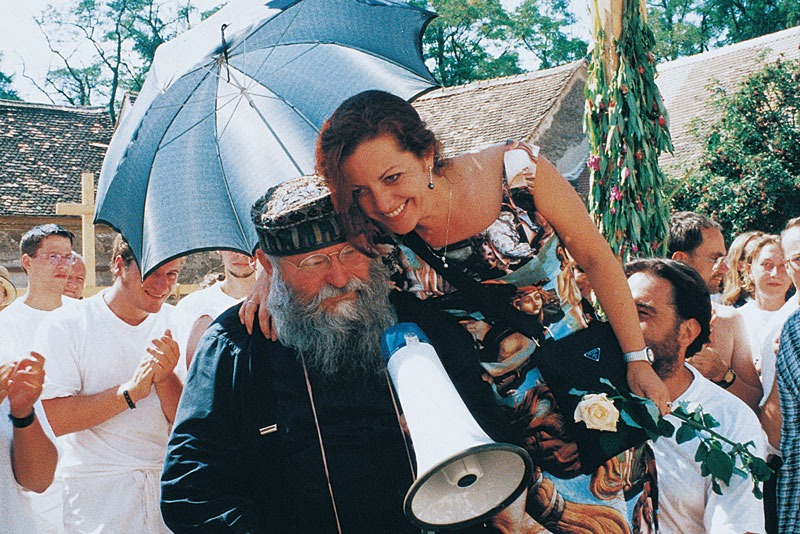
In answering my questions, Nitsch consistently sticks to using lowercase letters, even in proper names. Asked why, he replies: 'in the early religious christian texts, i was fascinated by the difference between majuscule and minuscule. i was especially stimulated by the ritual litany-like flow of the minuscule. lowercase letters have always attracted me. i feel great approval that the german linguists, the brothers grimm, demonstratively used lowercase letters as early as the romantic era. the real stimulus for me was stefan george, who made me use lowercase for my work. i was impressed by the typographical image of his poetry cycles. both the flowing ritual typeface and the liturgical verbal sound of the language, presented in the spoken chant, found my enthusiasm. without knowing each other beforehand, i learned that also my later friends from the wiener gruppe used lowercase letters radically. the traditional upper and lowercase writing used in the german language is too halting and wrongly defined by the multitude of nouns.’
How did you start doing art, and could you describe the social-political context of that time period in Austria?
i don’t think that artistic achievements can only be explained by external societal, social and political conditions. art is a matter that corresponds to a cosmic, inner urge caused by the event of creation of nature. certainly outside world conditions have an influence on the development of art. but is should not be overestimated. it has never been my aim to use my art to fight against external conditions. i always wanted to create intensity with my art.
You were one of the main protagonists of the Viennese Actionism movement. Could you please tell me what was the motivation, the background, behind this group?
when we started our art after world war II, we had to rebuild the exterminated culture.
Is the exposed, natural, emotive and expressionistic nature of Viennese Actionism connected to the sociopolitical situation in Austria after WWII? Is it a reaction with action?
my colleagues were more interested in politics and society than i was. they reacted artistically to the constrictions they found. i had more to do with the archetypal, with the collective dreams of humanity. myths and comparative religious intentions determined my work. my path was affected by the concerns of the greek tragedy through to the total work of art. my artistic interest was based on psychoanalytic insights and the ontological finding of being.
Viennese Actionism is often described as ‘an aesthetic way of praying’. Could you please elaborate on that?
there should not be a generalisation about the aims of actionism. each one of the four artists had his own view of the world. it was clear to me from the beginning that art is a metaphysical activity. the traditional concept of prayer need not be used in this context.
How do you see the difference between performance art, happenings, and Action art? What is at the core of Action art? How does it differ?
the essence of these art forms is that nothing is performed in the sense of the old traditional theatre. real events are being staged. for me, the happening has an impressionistic, fleeting character. actionism is deeper. it is the expressionistic form of performance art that evaluates psychoanalysis. the fluxus movement can be understood as a political evaluation of the art event. i wanted to consolidate the art of events through the theatre of orgies and mysteries. i create scores that make it possible to perform my total work of art over and over again in hundreds of years. the impact of the greek tragedy is very important to me.
You refer to the concept of intensity as a very important factor in your Actions, paintings, etc. What is this intensity?
that is a very difficult question. my concept of intensity cannot be measured and cannot be subjected by ranking systems. to associate intensity all too closely with morality is very difficult. still, ‘the law in my chest’ decides how far i can go. i mean an intensity that reaches extreme realisation of existence and does not harm anyone, but on the contrary, leads more intimately and deeper into being. i always talk about intense art.
You also refer to intensity as something that is inherent to other pieces of work (Schiele, Wagner). Could you please characterise what is that intensity that you see as a common principle?
all great art was, is and always will be intense. in summary, i would say that in art, intensity and the strong realisation of the general creative nature emerge through the intensive mastering, grasping and reaching of form. it would be presumptuous to claim that only my art is intense.
© Hermann Nitsch. Sepulture, 20062007, etching on colored paper (2x3m)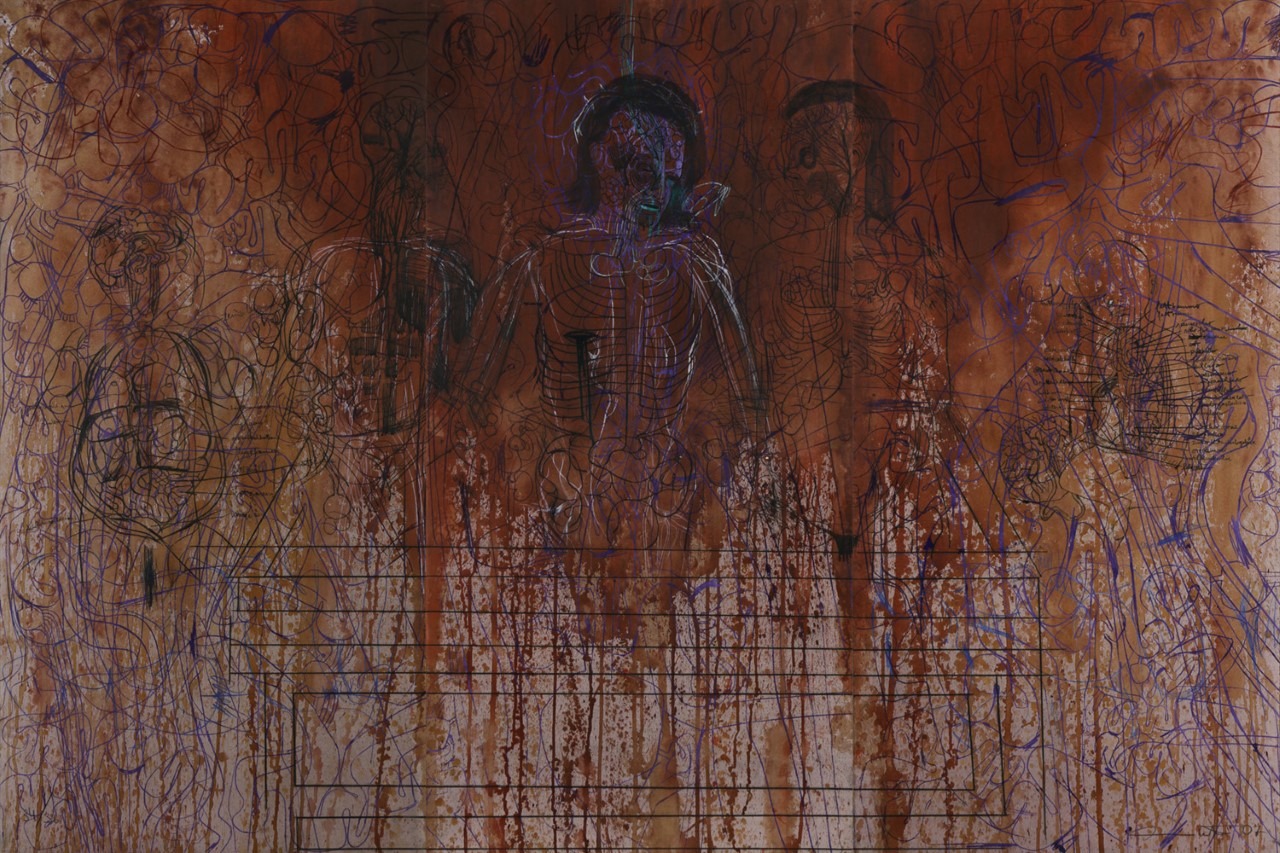
© Hermann Nitsch. Ressurection Triptych II, 2016, arcylic on canvas, cotton and wood (3x6m). Photo Christoph Stallkamp
Can you please tell me about the connection between Action art and painting? How do you see these relationships?
the relationship between painting and action is rather simple. from the term ‘action painting’ i actually developed the overarching term of action, action theatre, and thus also the orgies and mysteries theatre. action painting, in which a painter smears spilled, splashed, kneaded colour, slimes it onto the canvas and thereby extremely increases his sensual experience, is the first stage of the orgies and mysteries theatre, performance art. the painter who ecstatically sheds paint is already the first performer in my theatre. it is a small step then, leaving the canvas and using blood, flesh, and viscera instead of colour. since the performances of my action theatre require an incredible amount of effort in every direction and, unfortunately, also financially, the realisation of my action theatre is not always possible. in these cases, i limit myself to action painting and practice the first stage of my total work of art.

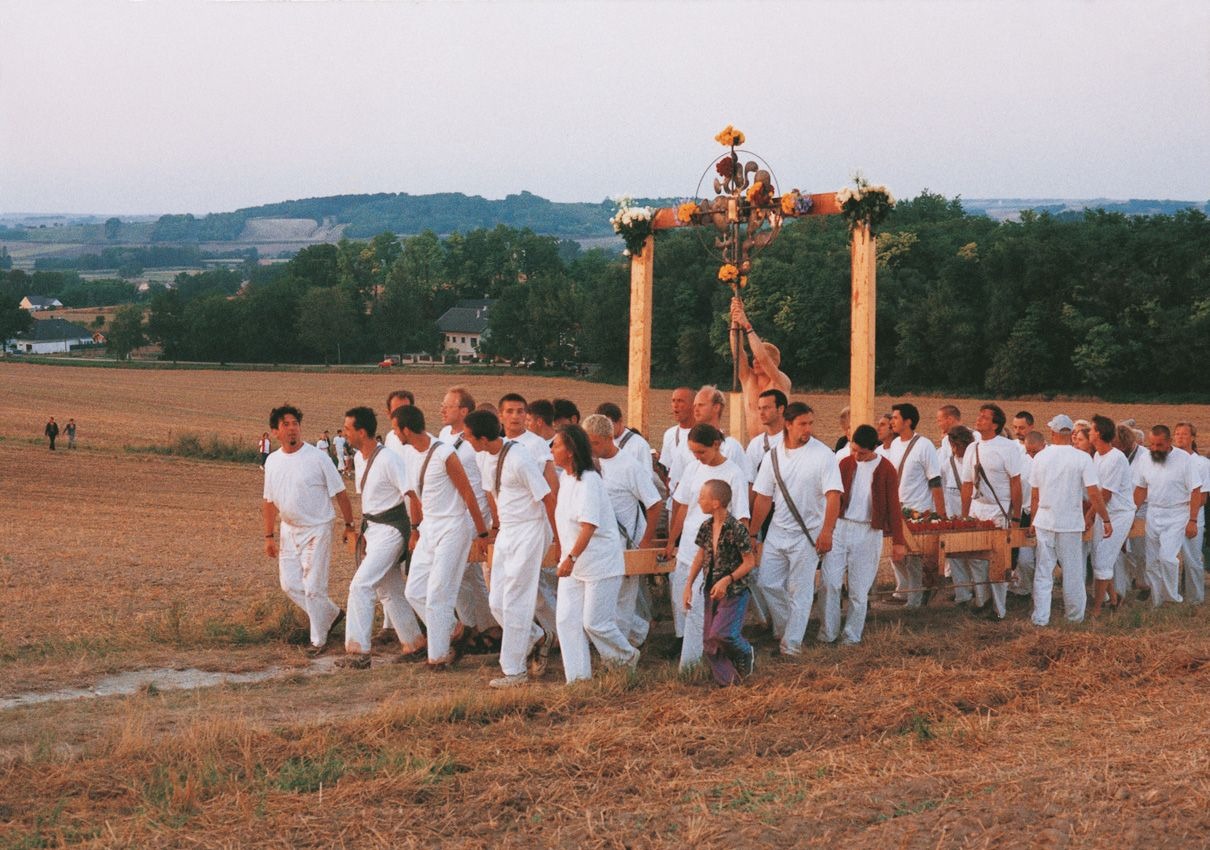
The exhibition in Riga will have a very significant title – Orgies and Mysteries Theatre. Can you please tell me about the history of this theatre? How did you create it?
my preoccupation with johann sebastian bach, wolfgang amadeus mozart, richard wagner, alexander scriabin, stefan george, and joris-karl huysmans inspired me to continue working on the idea of the gesamtkunstwerk. i wanted all the senses to be used in my action theatre and to be extremely combined with one another. it should be about a condensation of reality. the sense of smell, taste, sight, hearing and the ability to feel should be related to each other in terms of form. in the history of religions and philosophy, two concepts have come to light. the extreme, sensual experience increased to orgy and the mystery that claims holiness and transcendence. these two terms have always been viewed as opposites. through my radical or fundamental affirmation of life, triggered by Nietzsche, there is no separation between flesh and spirit, between sensual experience and experienced transcendence. every moment transcends. the dionysian orgy is sacred and the mystical experience is sacred. experiencing everything together at the same time has something to do with enlightenment.
i developed a theatre in which intensive, sensual, dionysian experience is equally aimed as is the mystical experience of the world as a whole. i always refer to my theatre as a school of direct experience.

Action, music, painting – they all come together as one in your Orgies and Mysteries Theatre. How do you see the unity of all those forms of expression?
i hope i don't repeat myself. real events are realised through my theatre. a real occurrence is to taste, smell, see, hear and touch and understand. realising my theatre automatically creates a total work of art.

Do you see the use of blood, animal viscera, grapes, etc. as a material, a ‘colour’, in your art? How did you come to use ‘natural liquids’ in your art?
in parallel to the informal painting and before that, preformed objects were built into a work of art. not only have they used only colours. i think of marcel duchamp, joseph beuys, daniel spoerri (nouveau réalisme). as a result, meat, fruit and all kinds of objects were used. events and objects as representatives of reality were condensed in the sense of form and turned into substances of art.
© Hermann Nitsch. The Architecture of the O.M. Theatre, Folding plan, 198492, silkscreen print and ink on paper 
What are Relics in the context of your Action art? Is that all that remains from the Actions, the voice from the past? How are they are arranged? Is this the way to preserve Action art?
in my painting i have always enjoyed staining canvas or white fabric, besmirching it, making it filthy. in the beginning, these processes were carried out with a brush and sponges. later i stopped using these tools, just defiled them. as part of the preparations for my actions, i was often in slaughterhouses. i saw the colour of the flesh and the entrails, the spilled blood that was washed away with hoses. most of all, i was impressed by the butchers’ aprons. they were covered with blood and stained all over. and this [took place] spontaneously! what i saw there was superior to my painting. with this in mind, after my actions, i collected all the fabrics, shirts and robes of the actors. these results have been tainted more spontaneously than is ever achievable through painting. the tradition of relics was initiated by yves klein, daniel spoerri, joseph beuys, and the vienna actionism.
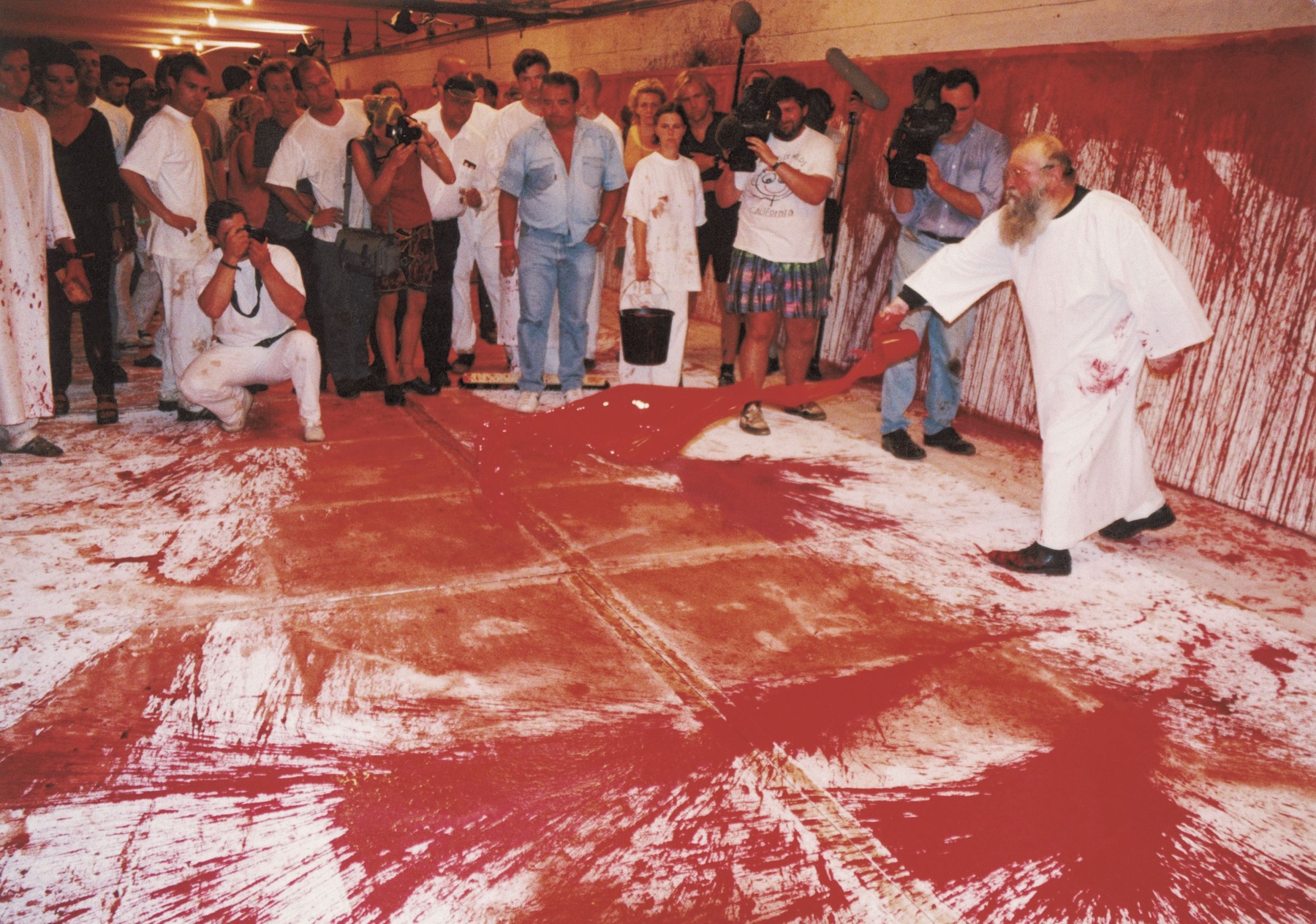

How do you choose the people who participate in your Actions? And how do you work with them when you create your pieces?
in the early 1960s, it was my friends who were enthusiastic about my ideas who helped me to realise my work. more and more people helped me and were ready to participate as painting actors or as actors and passive actors. it is currently not a problem to recruit contributors. they literally come from all over the world.
my score defines the actions to be performed.
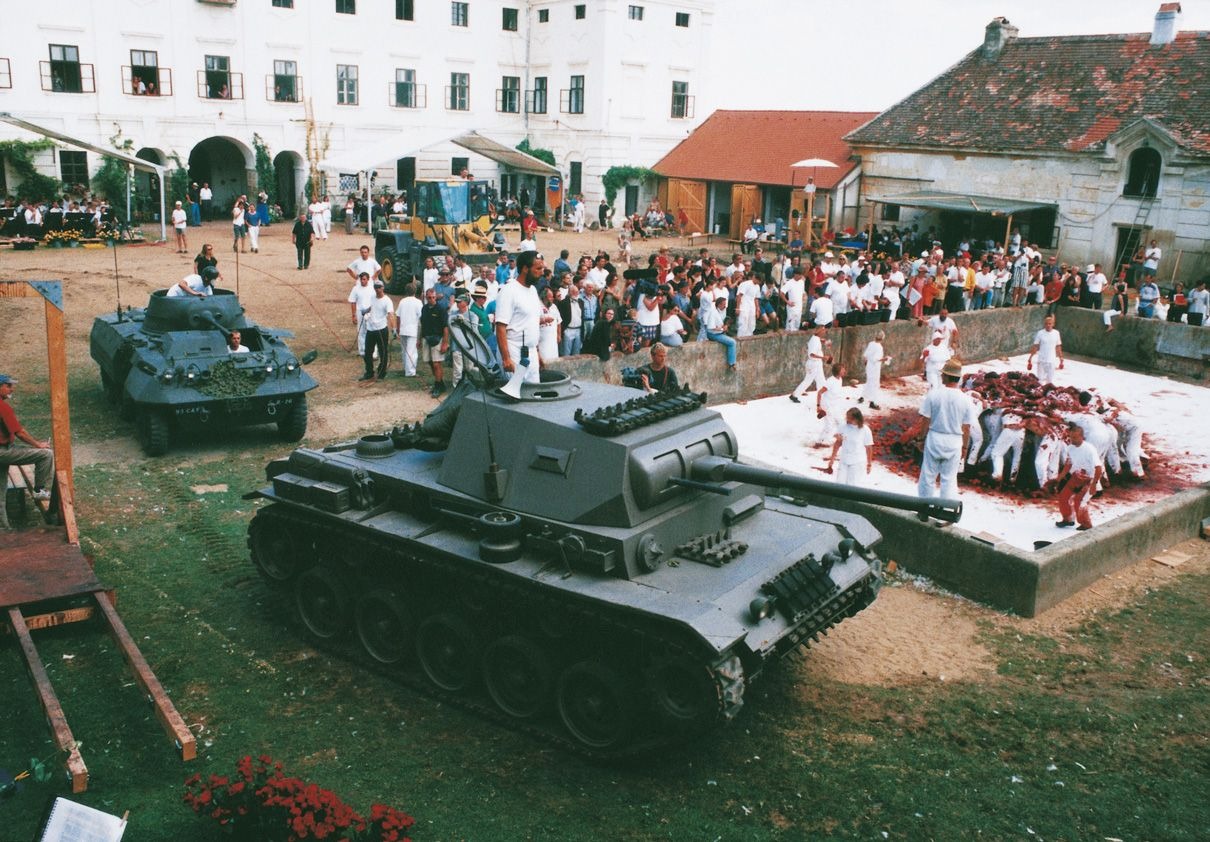

One of the greatest achievements of your art is the Six-Day Play. Can you tell me about the idea?
in the course of this interview i actually spoke very often of my orgies and mysteries theatre and thus, of my 6-days-play. it is the summary of all my intentions and experiences regarding performance art. an essential feature of my art was to let it flow into life, or every life should be condensed through the form. the large amount of time that my 6-days-play takes corresponds to the proximity to the happening of life.
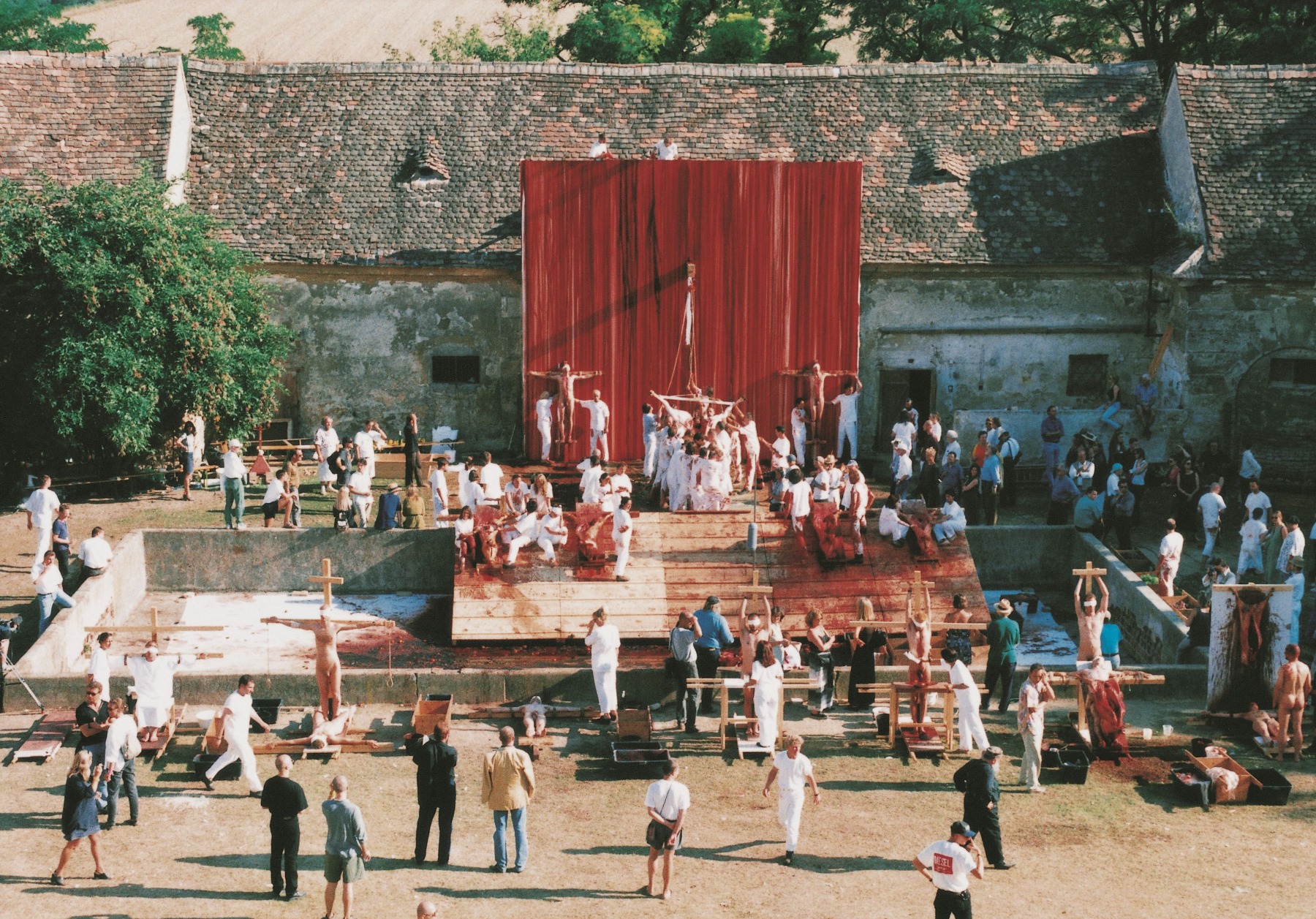
Next year you will recreate the Six-Day Play. How did you come to believe that this should be recreated?
my 6-day-play is a ‘work in progress’. it isn’t about a re-performance, but about a realisation of my concept that pushes into new areas.